Introduction
Mount Totumas Cloud Forest and Biological Reserve (MTCF) is a private landholding in Chiriquí Province, adjacent to La Amistad International Park (PILA) and encompassing 160 ha. It is named for the nearby Cerro Totumas (2,630 m, maximum elevation). Whereas the majority of Cerro Totumas is within the PILA boundaries, the western, lower slopes fall within the biological reserve. MTCF occupies the upper portion of the Río Colorado subwatershed (Fig. 1), immediately adjacent to and west of the headwaters of the Río Chiriquí Viejo watershed. Most of the land is forested, with some pasture areas and livestock, but little or no crop-based agriculture.
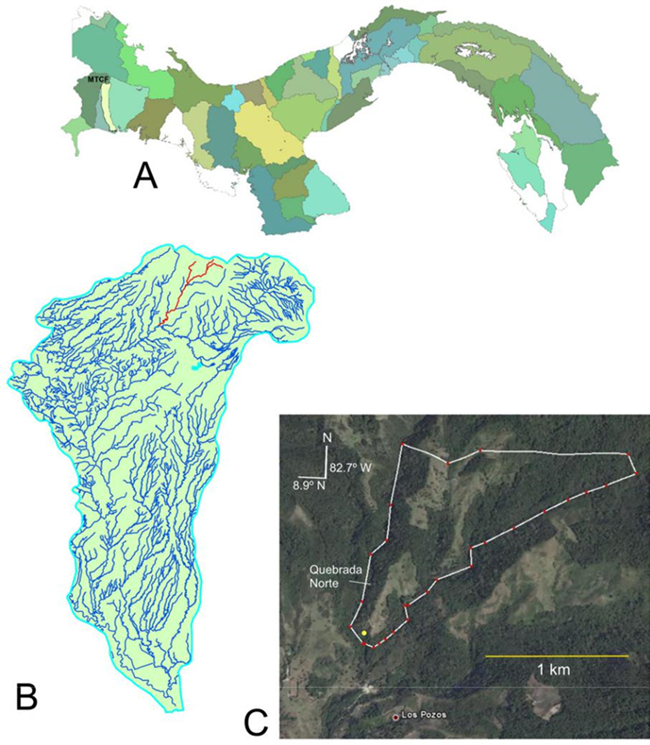
Figure 1 Maps. A) Major watersheds of Panama, with the Mount Totumas Cloud Forest and Biological Reserve (MTCF) location indicated on the far left in the Río Chiriquí Viejo watershed; B) hydrography of the Río Chiriquí Viejo watershed with the studied streams colored in red; C) expanded terrain view of the MTCF property (outlined in white). Location of Malaise trap indicated by a yellow dot.
Previously, we described 7 new species of micro-caddisflies from the upper Río Colorado subwatershed in MTCF (Thomson & Armitage, 2018). During 2017 and 2018, one of these streams, Quebrada Norte, was sampled monthly employing a Malaise trap. From these collections, several new species and new country records of microcaddisflies were identified. The purpose of this paper is to describe and provide figures for 6 new species of microcaddisflies for 3 genera known from Panama, as well as to describe 1 species under an informal designation and record 4 additional species for the country.
Materials and methods
Quebrada Norte, a second order tributary of the Río Colorado in the upper extent of that watershed was sampled monthly from December 2017 through December 2018. A Malaise trap was placed across the stream, roughly 80 m above its confluence with the Río Colorado, to collect the caddisflies. The sample location’s altitude was 1,920 m. Sampling intervals varied from 3 to 6 days dependent on the weather and amount of material that accumulated. Quebrada Norte, is approximately 1.0- 2.5 m wide, contains a variety of substrates ranging from small boulders to fine sand, and joins the Río Colorado near the entrance to MTCF (Fig. 1C). The riparian corridor bordering this stream is heavily wooded along most of its extent.
Morphological terminology used for male genitalia generally follows that of Marshall (1979). For simplicity, paired structures are discussed in the singular. Procedures for specimen preparation followed those explained in detail by Blahnik et al. (2007). For specimen examination and illustration, cleared genitalia were placed in a watch glass with glycerin and cotton. Genitalia were examined with an Olympus BX43 compound microscope at 250-500 × magnification. Structures were traced in pencil with the use of a camera lucida (drawing tube) mounted on the microscope. Pencil sketches were then scanned (Fujitsu ScanScap S1500M scanner) and were then edited and digitally inked in Adobe Photoshop and Illustrator (CS5.1). Electronic “drawing” was completed with the aid of a graphics tablet (Bamboo Pen, Wacom Company, Limited). Species descriptions were con structed using the program DELTA (Dallwitz et al., 2016). All specimens included in this publication are stored in 80% ethyl alcohol. Holotypes of species described are deposited in the Museo de Invertebrados de la Universidad de Panamá (MIUP).
Descriptions
Leucotrichia Mosely
Leucotrichia (Trichoptera: Hydroptilidae: Leucotri-chiinae: Leucotrichiini) is represented by 43 species endemic to the New World and distributed in North America, Central America, and northern South America (Santos, Nessimian et al., 2016; Thomson & Holzenthal, 2015). Previously, 7 species were recorded from Panama (Armitage et al., 2015, 2016, 2018; Flint, 1970; Harris & Armitage, 2019).
Leucotrichia cultrata Thomson and Armitage, sp. nov. http://zoobank.org/urn:lsid:zoobank.org:act:825F8D13-6D87-4012-9D0E-D6FCD33D4D40 (Fig. 2)
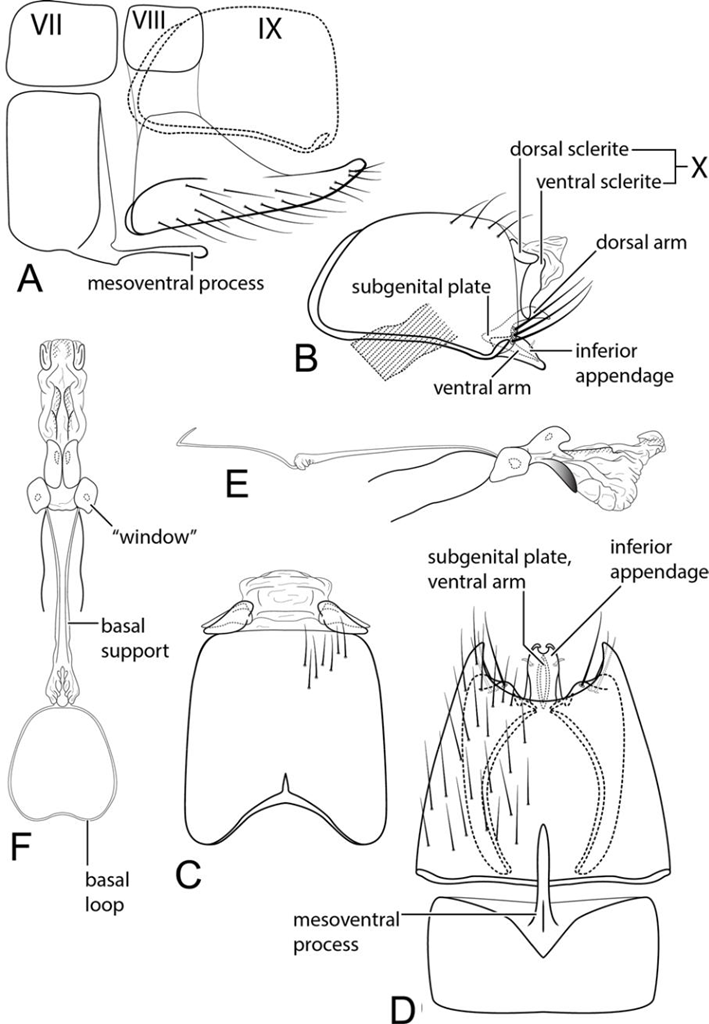
Figure 2 Leucotrichia cultrata sp. nov. Male genitalia: A) segments VII-VIII and segment IX margin, lateral; B) segments IX-X, lateral (base of phallus crosshatched); C) segments IX-X, dorsal; D) segments VII-IX, ventral; E) phallus, lateral; F) phallus, dorsal.
Diagnosis. Leucotrichia cultrata sp. nov., is most similar to L. hispida Thomson and Holzenthal and L. viridis Flint. These species share a similar form in the apex of the phallus (particularly in the membranous ventral “bulge”), the presence of a mesoventral process on abdominal segment VII, and the general shape of the inferior appendage when viewed laterally. Leucotrichia cultrata can be separated by the presence of the prominent dorsal arm of the subgenital plate, which is lacking in both other 2 species.
Holotype male: forewing length 2.6-2.8 mm (n = 3). Head unmodified, with 3 ocelli; antennae unmodified. Tibial spur count 1, 3, 4. Color in alcohol brown, denuded. Genitalia: abdominal sternum VII with digitate mesoventral process (Fig. 2B, D). Sternum VIII with posteroventral projection, in ventral view with posterior margin concave (Fig. 2B, D). Segment IX anterolateral margin convex; posterolateral margin broadly convex; in dorsal view anterior margin concave, posterior margin straight (Fig. 2C). Tergum X with dorsal sclerite simple; ventral sclerite semielliptic, posterior margin with small mesal projection (Fig. 2B); membranous apex small. Subgenital plate with dorsal arm simple, bent posteriorly, apex pointed; ventral arm straight, simple, apex pointed (Fig. 2B); in ventral view narrow, oval. Inferior appendage broadest mesally, base subquadrate, apex rounded, bearing single dorsal spine (Fig. 2B); in ventral view (Fig. 2D) almost entirely fused, with small rounded emargination at apex. Phallus tubular basally, constricted at midlength with median complex bearing basal loop with elongate basal supports and spherical dorsal “windows”; membranous apex bearing ventral “bulge”, elongate ventro-basal sclerite, and pair of small apicodorsal lobes (Fig. 2E, F).
Taxonomic summary
Holotype male: (MIUP-T-TRI-001): Panama, Chiriqui Province, Cuenca 102, MTCF, Quebrada Norte, 8°52’25.0” N, 82°41’25.8” W, 1,920 m, Malaise trap, J. Dietrich, 8-11-Nov-2018.
Other material examined: 2 males, same data as holotype, except 10-15-Jul-2018.
Etymology: cultratus, Latin for “knife-shaped,” referring to the shape of the prominent dorsal arm of the subgenital plate.
Metrichia Ross
Metrichia (Trichoptera: Hydroptilidae: Hydroptilinae: Ochrotrichiini) is represented by at least 136 species endemic to the New World and distributed in the Americas (Harris & Armitage, 2015, 2019; Armitage & Harris, 2020; Holzenthal & Calor, 2017; Santos, Takyia et al., 2016; Thomson & Armitage, 2018). Previously, 31 species were recorded from Panama (Armitage & Harris 2018, 2020; Armitage et al., 2015, 2016, 2020; Harris & Armitage, 2019; Thomson & Armitage, 2018). Herein we describe and Figure 2 new species and 1 species under an informal designation. Later in this publication, we report 4 new country records for Panama.
Metrichia akidion Thomson and Armitage, sp. nov.
http://zoobank.org/urn:lsid:zoobank.org:act:338AF913-D141-4A15-9A84-63A5FA277375 (Fig. 3)
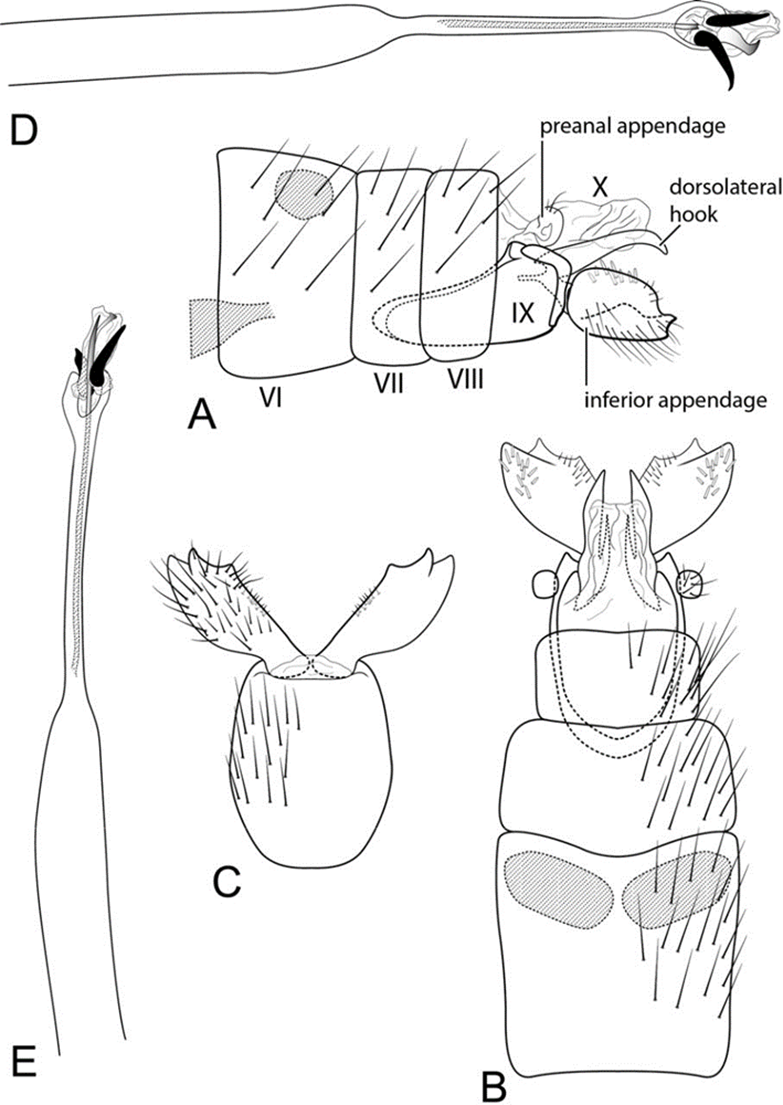
Figure 3 Metrichia akidion sp. nov. Male genitalia: A) segments VI-X, lateral (base of phallus crosshatched); B) segments VI-X, dorsal; C) segment IX, ventral; D) phallus, lateral; E) phallus, dorsal.
Diagnosis. Metrichia akidion sp. nov. is most like M. rona Flint. In both species, prominent subapical spines are present on the phallus. Also, the inferior appendage has a similar shape when viewed laterally. However, the peg-like setae on the interior surface of the inferior appendage in M. akidion are lacking in M. rona. Additionally, the dorsolateral hook in M. adkidion is larger, more prominent, and extends higher above the inferior appendage than in M. rona.
Holotype male: forewing length 2.2-2.8 mm (n = 3). Head unmodified, with 3 ocelli; antennae unmodified. Tibial spur count 1, 3, 4. Color in alcohol brown, denuded. Genitalia: abdominal segment VI with pair of rounded internal pouches (Fig. 3A, B). Abdominal sternum VII without mesoventral process (Fig. 3A). Sternum VIII unmodified. Segment IX anterolateral margin convex, narrowing and withdrawn into segments VII-VIII (Fig. 3A, B); posterolateral margin convex; in dorsal view with posterior margin membranous. Tergum X membranous, amorphous (Fig. 3A). Preanal appendage short, suborbicular (Fig. 3A, B). Dorsolateral hook large, with apex decurved (Fig. 3A). Inferior appendage setose, subquadrate with small-pointed projection on posterior margin; with stout pegs on dorsal surface (Fig. 3B). Phallus widest at base, narrowing to median constriction, membranous apex with 2 heavily sclerotized, subapical spines (Fig. 3D, E); ejaculatory duct strongly sclerotized.
Taxonomic summary
Holotype male: MIUP-T-TRI-002, Panama, Chiriqui Province, Cuenca 102, MTCF, Quebrada Norte, 8º52’25.0” N, 82º41’25.8” W, 1,920 m, Malaise trap, J. Dietrich, 8-13-Mar-2018.
Other material examined: 2 males, same data as holotype, except 8-11-Nov-2018.
Etymology: diminutive of akidos, Greek for “point, beak, barb,” referring to the small, pointed projection on the posterolateral margin of the inferior appendage.
Metrichia plax Thomson and Armitage, sp. nov.
http://zoobank.org/urn:lsid:zoobank.org:act:0959FA7E-BB5F-40E4-9E14-17AB5BB714B3 (Fig. 4)
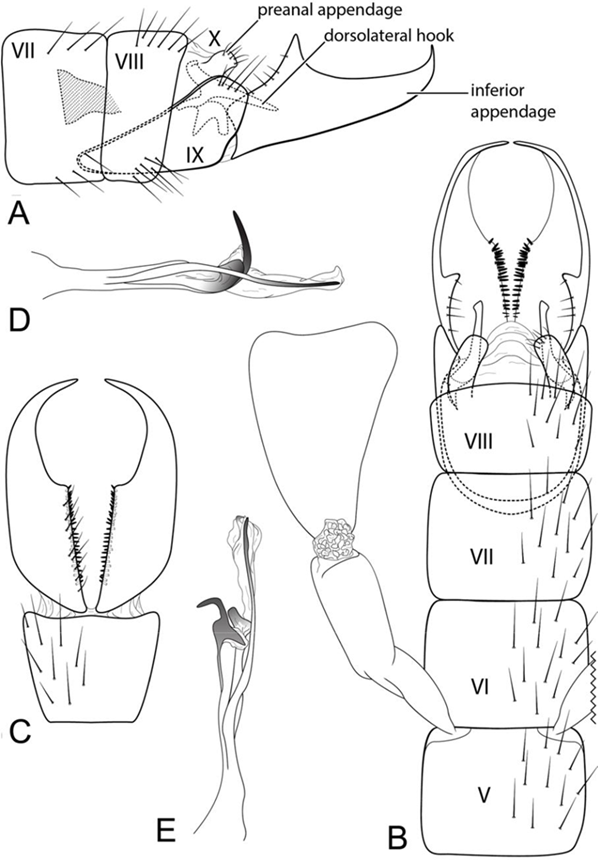
Figure 4 Metrichia plax sp. nov. Male genitalia: A) segments VII-X, lateral (base of phallus crosshatched); B) segments V-X, dorsal; C) segment IX, ventral; D) phallus, lateral; E) phallus, dorsal.
Diagnosis. Metrichia plax sp. nov. is most like M. calla Thomson and Armitage and M. sesquipedalis Bueno-Soria and Holzenthal. All 3 species bear elongate inferior appendages that narrow apically. When properly cleared, the presence of the elaborate structure emerging from between abdominal segments can be used to differentiate M. plax from the other 2 species. Additionally, M. plax can also be separated by the straight dorsolateral hook, which is curved in both M. calla and M. sesquipedalis.
Holotype male: forewing length 2.8-3.0 mm (n = 2). Head unmodified, with 3 ocelli; antennae unmodified. Tibial spur count 1, 3, 4. Color in alcohol brown, denuded. Genitalia: elongate structure emerging between abdominal segments V and VI (Fig 4B); apex with large, flat, subtriangular plate. Abdominal sternum VII without mesoventral process (Fig. 4A). Sternum VIII unmodified (Fig. 4A). Segment IX anterolateral margin convex, narrowing and withdrawn into segments VII-VIII; posterolateral margin convex (Fig. 4A); in dorsal view with posterior margin membranous (Fig 4B). Tergum X small, membranous, amorphous (Fig. 4A, B). Preanal appendage short, quadrate (Fig. 4A, B). Dorsolateral hook straight, simple (Fig. 4A); in dorsal view apex truncate and slightly enlarged (Fig 4B). Inferior appendage elongate, dorsal margin with pointed projection occurring 1/3 length from base (Fig. 4A), interior margin bearing row of peg-like setae (Fig. 4B, C), truncate basally, apex narrowly pointed and curved strongly inward (Fig. 4B, C). Phallus tubular, membranous apex with 1 spine at midlength; spine prominent and bent at right angle (Fig. 4D, E); ejaculatory duct heavily sclerotized.
Taxonomic summary
Holotype male: MIUP-T-TRI-004, Panama, Chiriqui Province, Cuenca 102, MTCF, Quebrada Norte, 8º52’25.0” N, 82º41’25.8” W, 1,920 m, Malaise trap, J. Dietrich, 8-13-Jun-2018.
Other material examined: 1 male, same as for holotype, except 6-9-Oct-2018.
Etymology: plax, Greek for “anything flat and wide, plate, tablet,” referring to the large, flat plate on the apex of the structure emerging from between abdominal segments V and VI.
Ochrotrichia Ross
Ochrotrichia (Trichoptera: Hydroptilidae: Hydropti-linae: Ochrotrichiini) is represented by at least 167 species endemic to the New World and distributed in North, Central, and South America and the West Indies (Armitage et al., 2016, 2020; Armitage & Harris, 2018; Cavalcante et al., 2018; Harris & Armitage, 2019; Holzenthal & Calor, 2017; Thomson & Armitage, 2018). Previously, 33 species were recorded from Panama (Armitage & Harris, 2018; Armitage et al., 2015, 2016, 2020; Bueno-Soria & Holzenthal, 2004; Harris & Armitage, 2019; Thomson & Armitage, 2018). Herein we describe and Figure 3 new species from MTCF.
Ochrotrichia alma Thomson and Armitage, sp. nov.
http://zoobank.org/urn:lsid:zoobank.org:act:9D561F95-2576-4085-A8D8-A92730DE0B87 (Fig. 5)
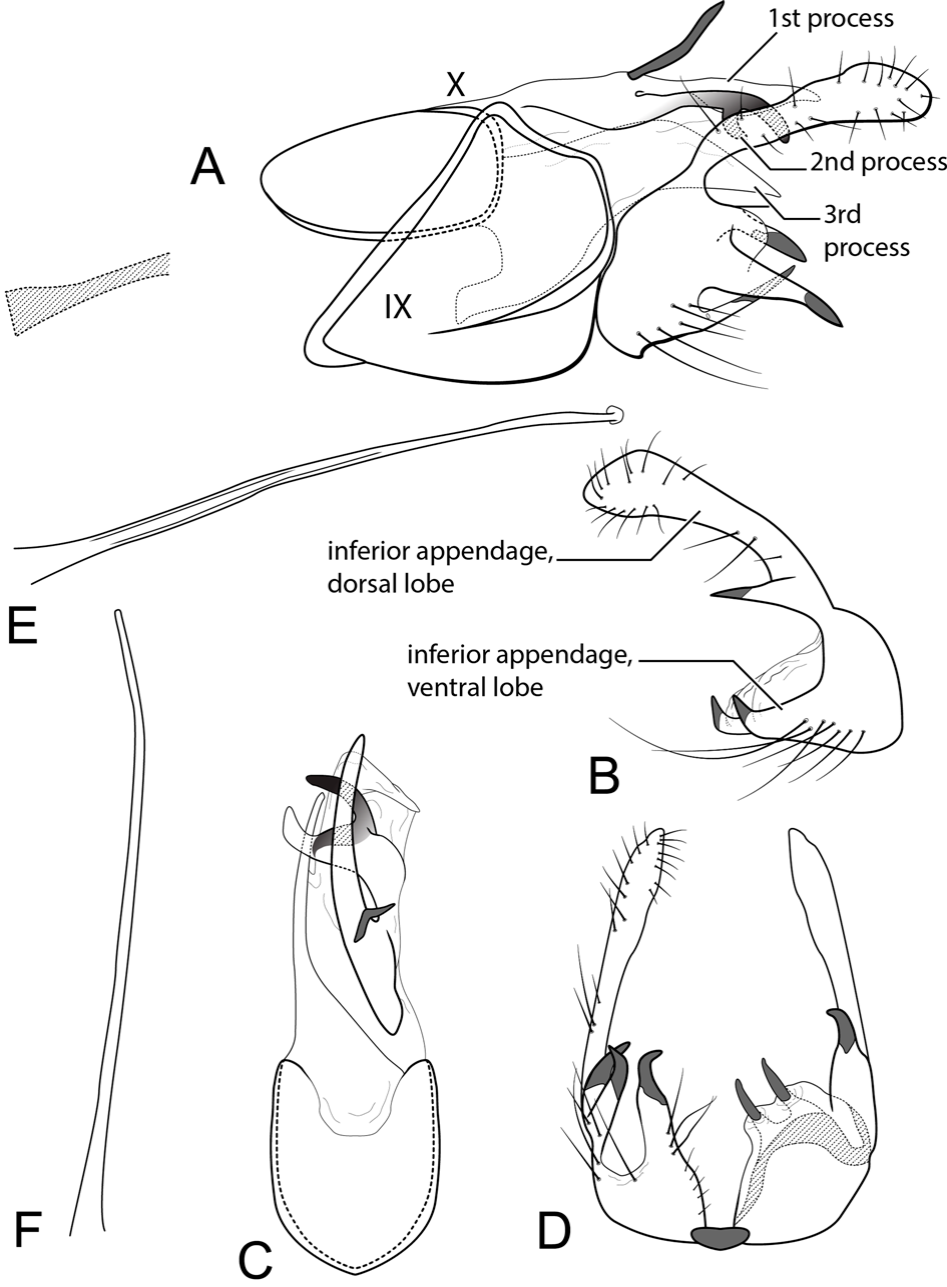
Figure 5 Ochrotrichia alma sp. nov. Male genitalia: A) segments IX-X, lateral left side (base of phallus crosshatched); B) inferior appendage, lateral right side; C) segments IX-X, dorsal; D) inferior appendages, ventral; E) phallus, lateral; F) phallus, dorsal.
Diagnosis. Ochrotrichia alma sp. nov. is most similar to O. anticheirion Thomson and Armitage, O. arranca (Mosely), and O. moselyi Flint. All 4 species feature asymmetrical inferior appendages with a simple dorsal lobe and a ventral lobe with spine-bearing processes. For each of these species, the arrangement of the spine-bearing processes is similar but unique. O. alma can be distinguished from O. arranca and O. anticheirion by the presence of a single prominent seta on the 1st process of tergum X, rather than 2 setae. The presence of the 3rd process on tergum X (most apparent when viewed dorsally) separates O. alma from O. moselyi.
Holotype male: forewing length 2.0-2.4 mm (n = 10). Head unmodified, with 3 ocelli; antennae unmodified. Tibial spur count 0, 3, 4. Color in alcohol brown, denuded. Genitalia: abdominal sternum VII without mesoventral process. Sternum VIII unmodified. Segment IX anterolateral margin concave, posterolateral margin fused dorsolaterally with tergum X (Fig. 5A). Tergum X sclerotized, highly developed with 3 processes (Fig. 5A): 1st process elongate, digitate, with 1 large mesodorsal seta; 2nd process apex bifid and extremely sclerotized; 3rd process slender, simple, apparent in dorsal view. Inferior appendage setose, asymmetrical, both with dorsal and ventral lobes (Fig. 5A, B, D); dorsal lobe on both sides approximately 3 times longer than wide, slightly enlarged apically, apex rounded; ventral lobe on left side bearing 3 digitate processes, each ending in a stout spine; ventral lobe on right side bearing 3 pointed processes, each ending in a stout spine, basal 2 separated from 3rd by membranous sheath. Phallus tubular, elongate, simple, thread-like (Fig. 5E, F).
Taxonomic summary
Holotype male: Panama, Chiriqui Province, Cuenca 102, MTCF, Quebrada Norte, 8º 52’ 25.0” N, 82º41’25.8” W, 1,920 m, Malaise trap, J. Dietrich, 10-17-May-2018, (MIUP-T-TRI-005).
Other material examined: 9 males, same as for holotype, except 10-15-Jul-2018.
Etymology: we take great pleasure in naming this species after Alma Dietrich, co-owner of the Mount Totumas Cloud Forest and Biological Reserve, for her support and encouragement of our research.
Ochrotrichia paxilla Thomson and Armitage, sp. nov.
http://zoobank.org/urn:lsid:zoobank.org:act:4E7750F9-422A-4AF2-B502-BA87A33E29F4 (Fig. 6)
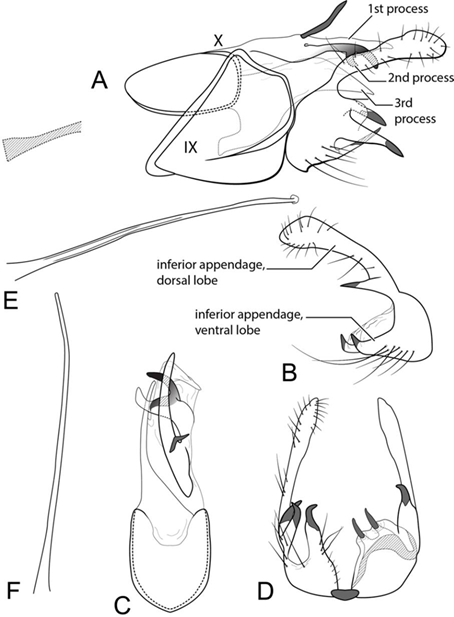
Figure 6 Ochrotrichia paxilla sp. nov. Male genitalia: A) segments VIII-X, lateral (base of phallus crosshatched); B) segments IX-X, dorsal; C) segment IX, ventral; D) phallus, lateral; E) phallus, dorsal.
Diagnosis. Remarkably similar to O. regina Bueno-Soria and Santiago-Fragoso. In both species, the inferior appendage is large, with peg-like setae on the inner surface, and tergum X bears processes that are apically hooked. However, the peg-like setae in O. regina occur in a continuous band, while they are grouped into 2 clusters at the mid-length and the apex in O. paxilla.
Holotype male: forewing length 2.2-2.7 mm (n = 12). Head unmodified, with 3 ocelli; antennae unmodified. Tibial spur count 0, 3, 4. Color in alcohol brown, denuded. Genitalia: abdominal sternum VII without mesoventral process. Sternum VIII unmodified. Segment IX anterolateral margin concave, with a mesal rounded cleft, posterolateral margin fused dorsolaterally with tergum X (Fig. 6A). Tergum X sclerotized, highly developed with 3 processes (Fig. 6A): 1st process elongate, apex decurved; 2nd process straight, apex hooked slightly upward; 3rd process simple, membranous basally. Inferior appendage setose, broadest at base, apex rounded (Fig. 6A), interior surface with patches of peg-like setae at mid-length and apex (Fig. 6B). Phallus tubular, elongate, simple, thread-like (Fig. 6D, E).
Taxonomic summary
Holotype male: Panama, Chiriqui Province, Cuenca 102, MTCF, Quebrada Norte, 8º 52’ 25.0” N, 82º41’25.8” W, 1,920 m, malaise trap, J. Dietrich, 16-20-Mar-2018 (MIUP-T-TRI-006).
Paratype: 1 male, same as for holotype, except B. Armitage, 28-Jan, 2-Feb-2018 (MIUP-T-TRI-007).
Additional material examined: 2 males, same as for holotype, except J. Dietrich, 16-20-Apr-2018; 3 males, same as for holotype, except 8-13-Jun-2018; 1 male, same as for holotype, except 9-12-Sep-2018; 2 males, same as for holotype, except 8-11-Oct-2018; 2 males, same as for holotype, except 8-11-Nov-2018.
Etymology: paxillus, Latin for “peg, small stake”, referring to the peg-like setae on the inner surface of the inferior appendage.
Ochrotrichia petersoni Thomson and Armitage, sp. nov.
http://zoobank.org/urn:lsid:zoobank.org:act:5F516D5B-2F27-48FE-9DF7-E4D28D0471D5 (Fig. 7)
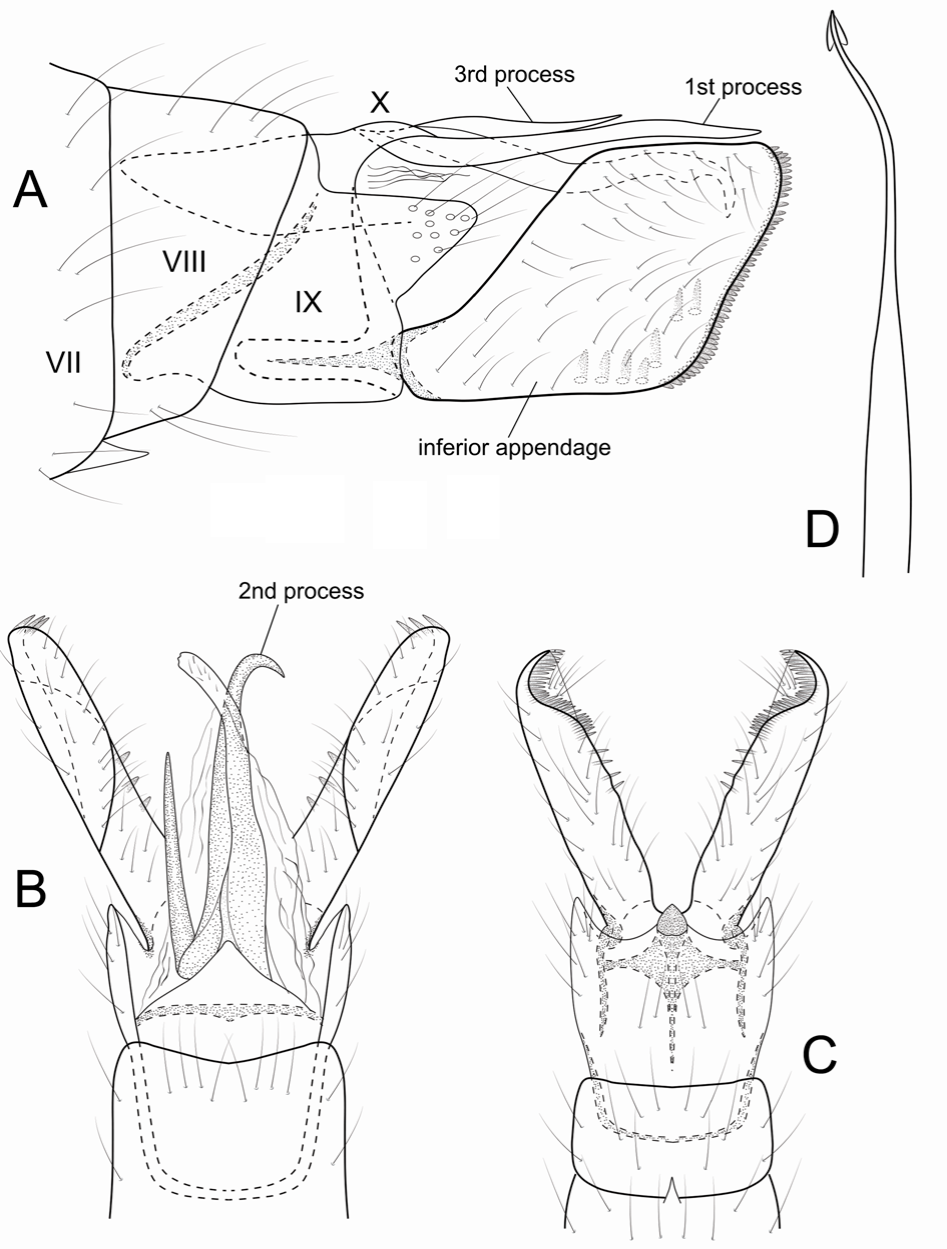
Figure 7 Ochrotrichia petersoni sp. nov. Male genitalia: A) segments VII-X, lateral; B) segments VIII-X, dorsal; C) segments VIIIX, ventral; D) phallus
Diagnosis. Ochrotrichia petersoni sp. nov., is known from 2 locations, west (holotype) and east of Volcan Baru. This species is most like O. gretae Bueno-Soria. The inferior appendages are similar, with a generally subquadrate shape and an apical band of peg-like setae. However, the posterolateral margin of the inferior appendage is overall truncate in O. petersoni, while in O. gretae it is broadly produced dorsolaterally.
Holotype male: forewing length 2.9 mm (n = 1). Head unmodified, with 3 ocelli; antennae unmodified. Tibial spur count 0, 3, 4. Color in alcohol brown, denuded. Genitalia: abdominal sternum VII with small pointed mesoventral process (Fig. 7A). Sternum VIII unmodified (Fig. 7A). Segment IX anterolateral margin concave, posterolateral margin fused dorsolaterally with tergum X (Fig. 7A).
Tergum X sclerotized, highly developed with 3 processes (Fig. 7A, B): 1st process simple, apex digitate in dorsal view; 2nd process simple, elongate, apex curved; 3rd process simple straight, apparent in dorsal view. Inferior appendage setose, subquadrate with truncate anteroventral production (Fig. 7A), posterior margin with row of peg-like setae (Fig. 7A, C). Phallus tubular, elongate, simple, thread-like (Fig. 7D).
Taxonomic summary
Holotype male: Panama, Chiriqui Province, Cuenca 102, MTCF, Quebrada Norte, 8º52’25.0” N, 82º41’25.8” W, 1,920 m, Malaise trap, 8-13-Aug-2018, J. Dietrich (MIUP-T-TRI-008).
Additional material examined: 1 male, Panama, Chirqui Province, Cuenca 108, Quebrada El Velo, Alto Quiel, E. of Finca Lerida, Price Peterson property, 8º49’13.5” N, 82º29’3.4” W, 1,782 m, Malaise trap, A. Cromer, 11-18-Oct-2016.
Etymology: we take great pleasure in naming this species after Price Peterson, founder of Hacienda La Esmeralda, S.A., for permitting us to collect on his property in the Boquete area of Chiriqui Province.
Metrichia PA-1
(Fig. 8)
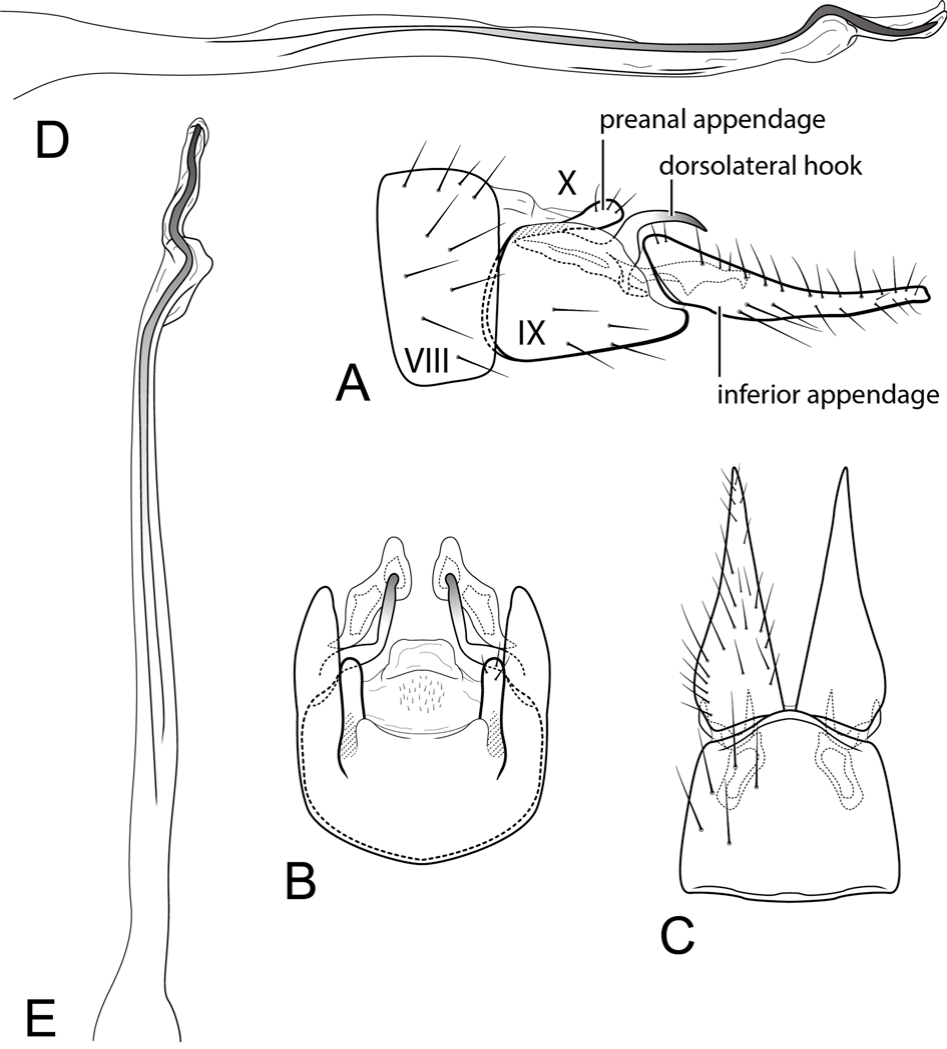
Figure 8 Metrichia PA-1. Male genitalia: A) segments VIII-X, lateral; B) segments IX-X, dorsal; C) segment IX, ventral; D) phallus, lateral; E) phallus, dorsal.
Diagnosis. Metrichia PA-1 is most like M. sesquipedalis Bueno-Soria and Holzenthal. Both species bear elongate inferior appendages, broadest basally and narrowing apically. The lack of spines on the phallus ápex differentiates M. oregma from M. sesquipedalis, which bears 3 hook-like spines.
Male: the head and body were lost after the single specimen was examined and described. No special features of the head or body were noted during our initial examination. Color in alcohol brown, denuded. Genitalia: abdominal sternum VII without mesoventral process (Fig. 8A). Sternum VIII unmodified (Fig. 8A). Segment IX anterolateral margin convex; posterolateral margin convex, produced posteroventrally (Fig. 8A); in dorsal view with posterior margin membranous (Fig. 8B). Tergum X small, membranous, amorphous (Fig. 8A, B). Preanal appendage small, digitate (Fig. 8A, B). Dorsolateral hook slender, curved (Fig. 8A). Inferior appendage setose, elongate, broadest basally, apex narrow (Fig. 8A). Phallus elongate, base originating in abdominal segment V, tubular, membranous apex, with single elongate spine extending apically within membranous sheath (Fig. 8D, E).
Taxonomic summary
Male: MIUP-T-TRI-003, Panama, Chiriqui Province, Cuenca 102, MTCF, Quebrada Norte, 8º52’25.0” N, 82º41’25.8” W, 1,920 m, Malaise trap, J. Dietrich, 16-20-Feb-2018.
Remarks
As noted above, the head and body of the single specimen collected were lost after identification and description. The fact that only 1 male was collected during 13 months of collecting with a Malaise trap (~ 65 days total collection period) indicates that this taxon is either exceedingly rare, or perhaps came from the Río Colorado, the parent stream to Quebrada Norte. We plan to do additional collections on the Río Colorado during a 6-month period in 2020-2021 (December through May) to collect more specimens of this taxon. Until then, the description and figures presented in this paper will serve to record its existence and allow any trichopterists in Panama and surrounding countries to recognize it. Zwick (1986), Stark (1995), and Stark and Armitage (2018) have used informal designations such as that employed here (PA-1) to provide information to others about presumed species (primarily unassociated adult females for stoneflies), and we have copied their practice in the current situation. The Trichoptera literature is replete with examples of this general practice (e.g., “Genus A”, “species B”, “sp. 1”), which were subsequently resolved through taxonomic revisions or additional collecting. Although some Metrichia species are known for specialized antennal morphology or unique clusters of setae on the abdomen, our original examination of this species detected nothing special in any regard.
New country records. The following 4 species are collected at MTCF are recorded from Panama for the first time.
Metrichia angulosa Bueno-Soria and Holzenthal, 2003 Type locality: Costa Rica: Puntarenas: Río Cotón in
Las Alturas, 8º56’16.8” N, 82º49’33.6” W, 1,360 m.
Material examined: 2 males, Panama, Chiriqui Province, Cuenca 102, MTCF, Quebrada Norte, 8º52’25.0” N, 82º41’25.8” W, 1,920 m, Malaise trap, 26-28-Nov-2017, J. Dietrich; 1 male, ibid., 16-20-Feb-2018; 1 male, ibid., 10-17-May-2018; 1 male, ibid., 8-11-Oct-2018.
Distribution: Costa Rica and Panama.
Metrichia mechuda Bueno-Soria and Holzenthal, 2003
Type locality: Costa Rica: San José: Río Savegra, near
San Gerardo de Dota, 9º19’48.0” N, 83º28’48.0” W, 2,200 m.
Material examined: 1 male, Panama, Chiriqui Province, Cuenca 102, MTCF, Quebrada Norte, 8º52’25.0” N, 82º41’25.8” W, 1,920 m, Malaise trap, 9-12-Sep-2018, J. Dietrich.
Distribution: Costa Rica and Panama.
Metrichia meta Bueno-Soria and Holzenthal, 2003
Type locality: Costa Rica: Guanacaste: Parque Nacional Rincón de la Vieja, Quebrada Zopilote, 10º45’54.0” N, 85º18’32.4” W, 785 m.
Material examined: 2 males: Panama, Chiriqui Province, Cuenca 102, MTCF, Quebrada Norte, 8º52’25.0” N, 82º41’25.8” W, 1,920 m, Malaise trap, 16-20-Apr-2018, J. Dietrich.
Distribution: Costa Rica and Panama.
Metrichia truncata Bueno-Soria and Holzenthal, 2003 Type locality: Costa Rica: Alajuela: Río Pizote, ca. 5 km (air) S Brasilia, 10º58’19.2” N, 84º20’42.0” W, 390 m
Material examined: 7 males, Panama, Chiriqui Province, Cuenca 102, MTCF, Quebrada Norte, 8º52’25.0” N, 82º41’25.8” W, 1,920 m, Malaise trap, 8-13-Jun-2018, J. Dietrich; 1 male, ibid., 10-15-Jul-2018; 1 male, ibid., 9-12-Sep-2018.
Distribution: Costa Rica and Panama.
Discussion
The addition of 10 new taxa for Panama in this publication increases the total number of microcaddisflies species in the country to 189. Following our first paper for MTCF, we decided to do an additional year of collecting using Malaise traps primarily to make sure that we had more thoroughly collected the caddisflies in Quebrada Norte. Prior collections in this stream were made by UV light traps. The microcaddisflies were identified as part of that effort. We never expected to have so many more new taxa. Obviously, we have not yet reached an asymptote for species richness in this drainage. We noted in the previous paper that microcaddisfly diversity generally decreases from lower to higher altitudes. We feel this remains true, but the decline with altitude might not be as precipitous as thought. Given the MTCF’s proximity to the Costa Rican border, where many other, different species are found, it is within the realm of possibility that additional microcaddisfly species, potentially new species, or new country records, will be recorded in the future from this biological reserve. The 4 new country records for Panama presented here were previously known only from Costa Rica.











 nueva página del texto (beta)
nueva página del texto (beta)


